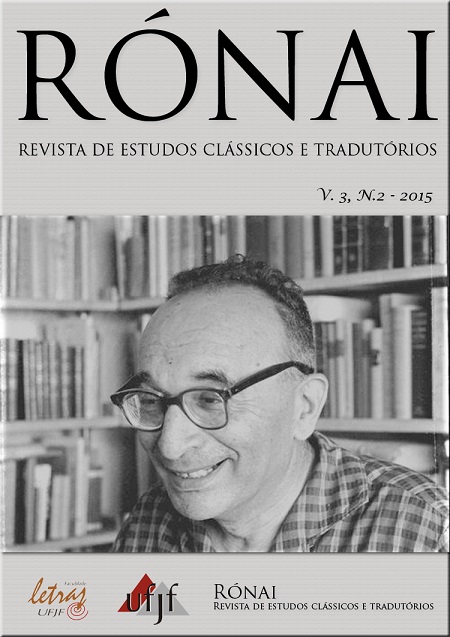Tradução de textos da filosofia oriental: peculiaridades e requisitos no caso da filosofia budista
Palabras clave:
tradução, sutra, filosofia oriental, filosofia budista, mahāyānaResumen
Este artigo pretende discutir algumas peculiaridades da tradução de textos da filosofia oriental para o português, especialmente dos sutras da filosofia budista mahāyāna. A discussão estrutura-se em torno de dois pontos principais: o primeiro aborda peculiaridades dos textos relativas ao espaço de tempo e diversidade de cultura através dos quais sobreviveram os manuscritos; e aborda também temas como sua confiabilidade (em termos de diferenças significativas nos corpos dos textos) e notas sobre a linguagem na qual estão registrados os manuscritos. O segundo núcleo reparte-se em dois pontos: os pré-requisitos para uma tradução desse porte, a partir dos fatores necessários para uma compreensão ampla do texto e de seus termos em seus próprios contextos; o estudo das trilhas que podemos seguir para tornar essa tradução acessível também ao público em geral, equilibrando a precisão acadêmica para uma compreensão relativamente adequada do texto e a necessidade de uma transmissão eficiente para o público leigo em geral.
Descargas
Citas
EDGERTON, F. Buddhist Hybrid Sanskrit Grammar and Dictionary. Volume I e II. Munshiram Manoharlal Publishers. Nova Délhi, India: 2011.
______. Buddhist Hybrid Sanskrit Reader. Delhi: Motilal Barnadassis Publishers Private Limited, 1996.
______. On Editing Buddhist Hybrid Sanskri. Journal of the American Oriental Society, Vol. 77, No. 03 (Jul. – Set., 1957), pp. 184-192.
GOMEZ, L. O.; SILK, J. A., Studies in the Literature of the Great Vehicle: Three Mahayana Buddhist Texts. Ann Arbor, 1989.
LEMOS, G. C. “Traduções da Literatura Ficcional Indiana Para o Português: Uma Questão Cultural”. Religare 9 (2), 162-166 , Dezembro de 2012
NARIMAN, G. K. Literary History of Sanskrit Buddhism. India: Pilgrims Publishing, 2007.
NOUSS, A. “Translation as Ethics”. in Comparative Law, Engaging Translation. 2014.
_________. “A tradução: no limiar”. Tradução de Izabela Leal. ALEA. Rio de Janeiro, vol. 14/1. pp. 13-34. jan-jun 2012
RAHULA, W. Zen and the Taming of the Bull. Gordon Fraser Book Publishers, 1978.
RUEGG, D. Seyfort. Introduction. In: CUTLER, Joshua W. C. (Ed.). The Great Treatise on the Stages of the Path to Enlightenment. Nova York: Snow Lion Publications, 2000. p. 22.
SKILTON, ANDREW T. "Dating the Samadhiraja Sutra." Journal of Indian Philosophy 27, 1999, 635-652
______. '"Four Recensions of the Samadhiraja Sutra." Indo-Iranian Journal 42, 1999, 335-336
SCHLEIERMACHER, F. “Sobre os diferentes métodos de traduzir”. Tradução de Celso Braida. Princípios, Natal, v. 14, n. 21, jan./jun. 2007
Descargas
Publicado
Cómo citar
Número
Sección
Licencia
Derechos de autor 2016 Ethel Panitsa Beluzzi

Esta obra está bajo una licencia internacional Creative Commons Atribución 4.0.
Derechos de autor
Los autores que publican en esta revista aceptan los siguientes términos:
1. Los autores y las autoras conservan los derechos de autor y le otorgan a la revista el derecho a la primera publicación, que está bajo la licencia Creative Commons Attribution License 4.0 Internacional.
2. Los autores y las autoras pueden publicar y compartir el trabajo con reconocimiento de la publicación inicial en esta revista.
3. Los autores y las autoras de las obras aprobadas autorizan a la revista a asignar el contenido de sus obras, después de la publicación, para su reproducción en indexadores de contenido, bibliotecas virtuales y similares.
Para obtener más información sobre Creative Commons Attribution License 4.0 Internacional, acceda a: https://creativecommons.org/licenses/by/4.0/deed.es
Exención editorial
El contenido de los artículos publicados es responsabilidad única y exclusiva de sus autores, y no representa la posición oficial de Rónai - Revista de Estudos Clássicos e Tradutórios o de la Faculdade de Letras de la Universidad Federal de Juiz de Fora o instituciones asociadas.



